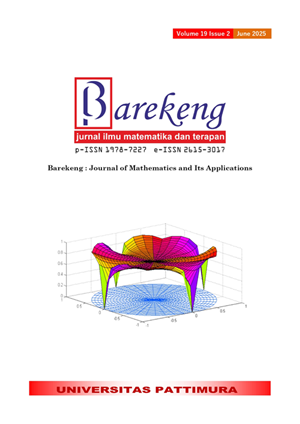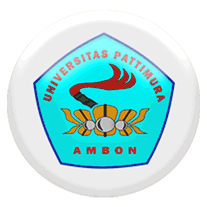SMALL AREA ESTIMATION OF CHILD UNDERNOURISHMENT PREVALENCE IN BALI AND NUSA TENGGARA
Abstract
Children under the age of 17 are particularly prone to undernutrition. Undernutrition can impair children’s growth and development. In the process of policy formulation, it is necessary to calculate a reliable estimate of the prevalence of child undernourishment at the smallest level possible. Using the data of SUSENAS 2023 from BPS, direct estimates at the regency/city level in Bali, West Nusa Tenggara (NTB), and East Nusa Tenggara (NTT) have relative standard error values of over 25% (RSE > 25%), making them less reliable for usage. To solve this, an indirect estimating method known as small area estimation (SAE) can be applied. This study employs SAE HB Lognormal to estimate the prevalence of undernutrition in children. The results of this study show that small area estimation using the HB Lognormal approach improved the reliability of estimates (RSE) of the prevalence of undernutrition in children at the regency/city level in Bali, NTB, and NTT.
Downloads
References
.[1] United Nations General Assembly, “TRANSFORMING OUR WORLD: THE 2030 AGENDA FOR SUSTAINABLE DEVELOPMENT.” United Nations, 2015, [Online]. Available: https://documents-dds-ny.un.org/doc/UNDOC/GEN/N15/291/89/PDF/N1529189.pdf?OpenElement.
United Nations, “SDGs GOAL 2 : Zero Hunger,” 2024. https://sdgs.un.org/goals/goal2#targets_and_indicators (accessed May 31, 2024).
V. J. B. Matrins et al., “LONG-LASTING EFFECTS OF UNDERNUTRITION,” Int. J. Environ. Res. Public Health, vol. 8, no. 6, pp. 1817–1846, 2011, doi: 10.3390/ijerph8061817.
D. K. Kinyoki et al., “MAPPING CHILD GROWTH FAILURE ACROSS LOW- AND MIDDLE-INCOME COUNTRIES,” Nature, vol. 577, no. 7789, pp. 231–234, 2020, doi: 10.1038/s41586-019-1878-8.
S. . Haslett, REVIEW OF SMALL AREA ESTIMATION METHODS IN INDONESIA [TINJAUAN METODE ESTIMASI AREA KECIL (SAE) DI INDONESIA]. Jakarta: World Food Programme; Badan Pusat Statistik; Politeknik Statistika STIS, 2023.
J. N. . Rao and I. Molina, SMALL AREA ESTIMATION, 2nd Ed. New Jersey: John Wiley & Sons, 2015.
M. Ghosh and J. N. K. Rao, “SMALL AREA ESTIMATION: AN APPRAISAL,” Stat. Sci., vol. 9, no. 1, Feb. 1994, doi: 10.1214/ss/1177010647.
J. N. K. Rao and M. Yu, “SMALL‐AREA ESTIMATION BY COMBINING TIME‐SERIES AND CROSS‐SECTIONAL DATA,” Can. J. Stat., vol. 22, no. 4, pp. 511–528, Dec. 1994, doi: 10.2307/3315407.
S. A. Yilema, Y. A. Shiferaw, T. Zewotir, and E. K. Muluneh, “MULTIVARIATE SMALL AREA ESTIMATION OF UNDERNUTRITION FOR CHILDREN UNDER FIVE USING OFFICIAL STATISTICS,” Stat. J. IAOS, vol. 38, no. 2, pp. 625–636, 2022, doi: 10.3233/SJI-220935.
K. Z. Ahsan, S. El Arifeen, M. A. Al-Mamun, S. H. Khan, and N. Chakraborty, “EFFECTS OF INDIVIDUAL, HOUSEHOLD AND COMMUNITY CHARACTERISTICS ON CHILD NUTRITIONAL STATUS IN THE SLUMS OF URBAN BANGLADESH,” Arch. Public Heal., vol. 75, no. 1, pp. 1–13, 2017, doi: 10.1186/s13690-017-0176-x.
S. Haslett, G. Jones, and A. Sefton, SMALL-AREA ESTIMATION OF POVERTY AND MALNUTRITION IN CAMBODIA, no. April. 2013.
S. Das, B. Baffour, and A. Richardson, “TRENDS IN CHRONIC CHILDHOOD UNDERNUTRITION IN BANGLADESH FOR SMALL DOMAINS,” Popul. Stud. (NY)., vol. 78, no. 1, pp. 43–61, Jan. 2024, doi: 10.1080/00324728.2023.2239772.
H. E. Catalán Nájera, “SMALL-AREA ESTIMATES OF STUNTING. Mexico 2010: Based on a hierarchical Bayesian estimator,” Spat. Spatiotemporal. Epidemiol., vol. 29, pp. 1–11, 2019, doi: 10.1016/j.sste.2019.01.001.
K. F. Muchie, A. K. Wanjoya, and S. M. Mwalili, “SMALL AREA ESTIMATION OF ZONE-LEVEL MALNUTRITION AMONG CHILDREN UNDER FIVE IN ETHIOPIA,” Math. Comput. Appl., vol. 27, no. 3, p. 44, 2022, doi: 10.3390/mca27030044.
S. Srivastava, H. Chandra, S. K. Singh, and A. K. Upadhyay, “MAPPING CHANGES IN DISTRICT LEVEL PREVALENCE OF CHILDHOOD STUNTING IN INDIA 1998-2016: AN APPLICATION OF SMALL AREA ESTIMATION TECHNIQUES,” SSM - Popul. Heal., vol. 14, no. January, p. 100748, 2021, doi: 10.1016/j.ssmph.2021.100748.
I. Ngaruye et al., “CHILD STUNTING PREVALENCE DETERMINATION AT SECTOR LEVEL IN RWANDA USING SMALL AREA ESTIMATION,” BMC Nutr., vol. 9, no. 1, pp. 1–8, 2023, doi: 10.1186/s40795-023-00806-w.
P. Budiraharti, R. Harini, and S. Sudrajat, “DETERMINAN TINGKAT KONSUMSI GIZI MAKRO RUMAH TANGGA DI PROVINSI RIAU: KAJIAN DEMOGRAFI DAN SPASIAL,” Maj. Geogr. Indones., vol. 36, no. 2, p. 111, 2022, doi: 10.22146/mgi.56011.
K. W. Ningsih, S. Syaparuddin, and S. Rahmadi, “DETERMINAN KONSUMSI RUMAH TANGGA MISKIN DI KECAMATAN DENDANG KABUPATEN TANJUNG JABUNG TIMUR,” e-Jurnal Ekon. Sumberd. dan Lingkung., vol. 8, no. 3, pp. 149–160, 2019, doi: 10.22437/jels.v8i3.11990.
Z. Yuda Perwira, U. A, and Y. W. I, “_saeHB: SMALL AREA ESTIMATION USING HIERARCHICAL BAYESIAN METHOD_,” 2023, [Online]. Available: https://cran.r-project.org/package=saeHB.
T. Yuniarty, I. Indahwati, and A. H. Wigena, “SMALL AREA ESTIMATION WITH HIERARCHICAL BAYES FOR CROSS-SECTIONAL AND TIME SERIES SKEWED DATA,” BAREKENG J. Ilmu Mat. dan Terap., vol. 18, no. 1, pp. 0493–0506, 2024, doi: 10.30598/barekengvol18iss1pp0493-0506.
V. Roy, “CONVERGENCE DIAGNOSTICS FOR MARKOV CHAIN MONTE CARLO,” Annu. Rev. Stat. Its Appl., vol. 7, no. 1, pp. 387–412, Mar. 2020, doi: 10.1146/annurev-statistics-031219-041300.
Copyright (c) 2025 Amalia Ndaru Nuriyo, Huda Muhammad Fajar, Jeremia Novaldi, Meautia Rahmi, Sabrina Do Miswa, Cucu Sumarni

This work is licensed under a Creative Commons Attribution-ShareAlike 4.0 International License.
Authors who publish with this Journal agree to the following terms:
- Author retain copyright and grant the journal right of first publication with the work simultaneously licensed under a creative commons attribution license that allow others to share the work within an acknowledgement of the work’s authorship and initial publication of this journal.
- Authors are able to enter into separate, additional contractual arrangement for the non-exclusive distribution of the journal’s published version of the work (e.g. acknowledgement of its initial publication in this journal).
- Authors are permitted and encouraged to post their work online (e.g. in institutional repositories or on their websites) prior to and during the submission process, as it can lead to productive exchanges, as well as earlier and greater citation of published works.






1.gif)



